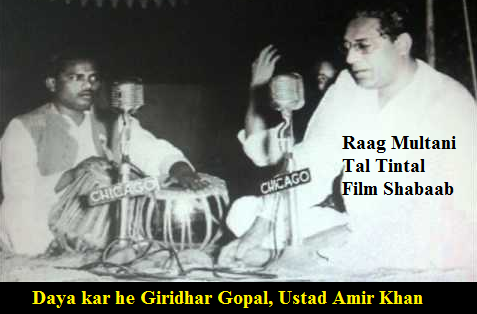Raaga Based Song of the Day: Daya kar he Giridhar Gopal…
Raag Multani, Tal Tintal
(by Ustad Amir Khan)
We have completed forty-two days of Raaga Based Songs of the Day. Our first post in the series was titled ‘Raaga Based Song Of The Day #1’ and the song was a Mohammad Rafi and Lata Mangeshkar song from the 1970 Shakti Samanta movie Pagla Kahin Ka: Tum mujhe youn bhula na paoge. It is in Raag Jhinjhoti, Tal Kaherava.
Our forty-second post was titled ‘Raaga Based Song Of The Day #42‘ and the song was a Ustad Bade Ghulam Ali Khan song that he sang for 1960 K Asif movie Mughal-e-Azam: Prem jogan ban ke. It is in Raag Sohani, Tal Dipchandi.
This blog has a number of posts on Raaga based songs in Hindi movies titled similarly; for example: ‘The Best Raaga Based Songs in Hindi Movies – Raaga Pilu – Part I‘.
In the last forty-two days of sharing Raaga based songs of the day, I have given you songs based on Raag Jhinjhoti, Gara, Bhimpalasi, Madhuvanti, Shivaranjani, Bihag, Pahadi, Sarang, Pilu, Bhairavi, Khammaj, Charukesi, Kalyan or Yaman, Desh, Malgunji, Kirwani, Kedar, Bageshri, Megh Malhar, Bhupali, Ahir Bhairav, Malkaush, Adana, Kafi, Rageshri, Jaunpuri, Tilang, Janasammohini, Chayanat, Shuddha Kalyan, Gaur Sarang, Jogiya, Asavari, Maru Bihag, Durga, Lalit, Puria Dhanashri, Bhinna Sahdja and Sohani. The only raag that has been repeated so far is Pahadi, the raaga of my home place.
Today, I give you a song in Raag Multani, Tal Tintal.
However, first, lets take up the value added learning of today. Today, we shall learn about Sarangi:
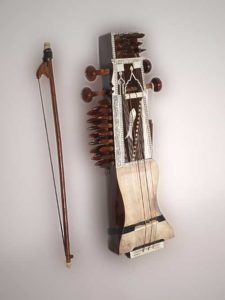
Sarangi is a bowed string instrument that is popular both in India and Nepal. Many songs of courtesans (eg, Unako yeh shikayat hai ke ham kuchh nahin kehte from the movie Adalat) and others of nawabs (such as Unake khayal aaye to aate chale gaye from the movie Laal Patthar) have this instrument played prominently. Sarangi is an instrument that comes the closest to human voice, especially in Karuna rasa (as is the case with both songs that I have given you).
As far as the meaning of the word Sarangi is concerned, some feel that it is a combination of two Sanskrit words: Saar (summary) and Ang (form). This would mean that the instrument that can summarise every style of music or playing.
Then there are others who feel that the word sarangi is a combination of two words Seh(Persian equivalent of three) and Rangi (Persian equivalent of coloured). They feel that the term Seh-rangi represents the three melody strings. However the most common folk etymology is that sarangi is derived from sol rang (a hundred colours) indicating its adaptability to many styles of vocal music, its flexible tunability, and its ability to produce a large palette of tonal colour and emotional nuance.
Generally, you don’t come across Sarangi performances as solo. These are normally accompanied by vocal. Indeed, one hardly comes across a Sarangi player who is not well versed with the vocal lyrics of the composition. Later, in this article, you would read about Ustad Amir Khan whose father was an accomplished Sarangi player but trained his son in vocal singing when the son showed interest more in vocal than Sarangi.
As I mentioned, today’s song is composed in Raag Multani, Tal Tintal.
Multani is a raaga that belongs to Todi Thaat. Its Jati is Audhav – Sampoorna, ie, five notes in Aaroha (Ni Sa ga Ma Pa Ni Sa) and and all seven notes in Avroha (Sa Ni dha Pa Ma ga re Sa). The time for performing this raaga is in the third prahar of the day, that is, from 1 to 4 PM. Multani is a very melodious Raag belonging to Todi Thaat. But, it does not have any shadow of Todi Ang. It is a Meend Pradhan Raag.
One of the other songs composed in Raag Multani is a beautiful Mohammad Rafi and Geeta Dutt song composed by SD Burman for the 1953 movie Jeevan Jyoti (Tal Dadra): Laga gayeen akhiyan.
About Tintal, I told you on the 19th day and 25th day, ie, in ‘Raaga Based Song Of The Day #19‘ and ‘Raaga Based Song Of The Day #25‘.
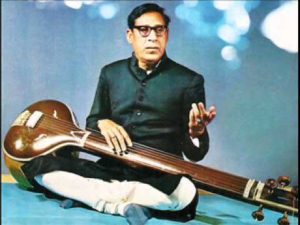 Ustad Amir Khan was born on 15 Aug 1912 in a musicians’ family in Indore. He died in a car accident in Calcutta on 13th Feb 1971. The same year, GoI conferred the Padma Bhushan award on him.
Ustad Amir Khan was born on 15 Aug 1912 in a musicians’ family in Indore. He died in a car accident in Calcutta on 13th Feb 1971. The same year, GoI conferred the Padma Bhushan award on him.
His father, Shahmir Khan, was a sarangi and veena player of the Bhendibazaar gharana. He served at the court of the Holkars of Indore. His grandfather, Change Khan, was a singer in the court of the last mughal emperor of India: Bahadurshah Zafar. Amir Ali’s mother died when he was nine years old. He had a younger brother, Bashir, who went on to become a sarangi player at the Indore station of All India Radio.
Even though his father initially tried to train him in sarangi playing, he was more interested in vocal and he had a rich baritone voice. After his initial failure to impress at the court of Maharaj Chakradhar Singh of Raigadh Sansthan in Madhya Pradesh (where they wanted him to sing Thumri that he wasn’t interested in), he developed his own gayaki (singing style), influenced by the styles of Abdul Waheed Khan (vilambit tempo), Rajab Ali Khan (taans) and Aman Ali Khan (merukhand). This unique style, known as the Indore Gharana, blends the spiritual flavor and grandeur of dhrupad with the ornate vividness of khayal.
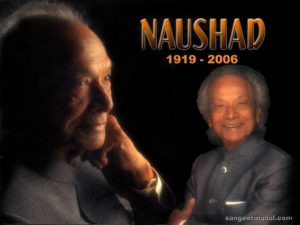 I have already told you several times that Naushad Ali was responsible for introducing raaga based songs in the Hindi movies. In his 1952 movie Baiju Bawra all 13 songs were based on some raaga or the other. Naushad roped in Amir Khan to sing five of them:
I have already told you several times that Naushad Ali was responsible for introducing raaga based songs in the Hindi movies. In his 1952 movie Baiju Bawra all 13 songs were based on some raaga or the other. Naushad roped in Amir Khan to sing five of them:
- ‘Tori Jai Jai Kartar’ (Raag Puriya Dhanashree)
- ‘Sargam’ (Raag Darbari)
- ‘Langar Kankariya Ji Na Maro’ (Raag Todi, with DV Paluskar)
- ‘Aaj Gaawat Man Mero Jhoomke’ (Raag Desi, with DV Paluskar)
- ‘Ghanana Ghanana Ghana Garjo Re’ (Raag Megh)
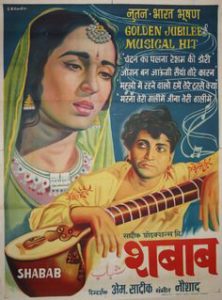 I am, however, giving you this song from 1954 M Sadiq movie Shabaab starring Bharat Bhushan and Nutan. The songs were penned by my favourite lyricist Shakeel Badayuni. There are two other songs from the movie that are my favourites:
I am, however, giving you this song from 1954 M Sadiq movie Shabaab starring Bharat Bhushan and Nutan. The songs were penned by my favourite lyricist Shakeel Badayuni. There are two other songs from the movie that are my favourites:
- Mohammad Rafi’s Aaye na baalam vaada karke.
- Hemant Kumar and Lata’s Chandan ka palna resham ki dori.
Of course the movie has another beautiful raaga based (Raag Bahar, with a trace of Raag Basant) song sung by Mohammad Rafi and Lata Mangeshkar: Man ki been matwari baaje, which I shall give you in due time.
I have already told you when I touched on the history of Hindustani Music (on the twenty-eighth day; please read: ‘Raaga Based Song Of The Day #28‘) that the fusion of Sanskrit and later Hindi style of music with Persian, Arabic and Sufi styles ensured that both Hindi Pandits and Muslim Ustads equally came up with songs that were to venerate gods and goddesses of each other. The most popular of these has been Lord Krishna. Indeed, many people are fond of bringing out this curious fact that the best Hindi bhajan: Man tadpat Hari darsan ko aaj has been put together by several muslims. Take this song itself: it has Shakeel Badayuni as lyricist, Naushad Ali as composer, Ustad Amir Khan as singer and it is from a movie Shabaab directed by M Sadiq. The raag Multani takes its name from the city of Multan (now in Pakistan). That’s been the beauty of our great nation: India.
Please enjoy Ustad Amir Khan sing in Raag Multani, Tal Tintal: Daya kar he Giridhar Gopal…….
Daya kar he Girdhar Gopal daya kar he Girdhar Gopal
Meera ke prabhu Nand Lal Meera ke prabhu Nand Lal
He Girdhar Gopal
Hath hai tore laaj hamari hath hai tore laaj hamari
O Mohan Banwari bigde kam sawar daya kar
Bigde kam saware he Girdhar Gopal
Daya kar he Girdhar Gopal daya kar he Girdhar Gopal
Meera ke prabhu Nand Lal Meera ke prabhu Nand Lal
He Girdhar Gopal.
We have intended to learn about Raaga based music whilst we entertain ourselves with Raaga based songs. So, lets, once again, take stock of our collective learning so far:
- On the first day we learnt about the Raaga system devised by Pandit Vishnu Narayan Bhatkhande, which is the prevalent system in Hindustani Classical Music and based on ten Thaats.
- On the second day we learnt about Tal or Taal.
- On the third day we learnt about characteristics of Raagas that included Swar, Jati, Thaat, Arohana and Avarohana, Vadi, Samvadi and Pakad.
- On the fourth day, we learnt about Sargam.
- On the fifth day, we learnt about notations used in Indian classical music or simply Swar Lipi.
- On the sixth day, we learnt about the Ras (sentiments) that Raagas evoke.
- On the seventh day, we learnt about various types of Swar: Shuddha, Achal, Vikrut, Komal and Teevra.
- On the eighth day, we learnt the parts of a composition in Indian Classical Music.
- On the ninth day, we learnt the names of some of the popular instruments used in Indian Classical Music.
- On the tenth day, we learnt about the sources of names of Raagas.
- On the eleventh day, we learnt about why Bhairavi is the first raag to be taught to beginners and also why it is the last in a performance.
- On the twelfth day, we learnt about Khammaj Thaat.
- On the thirteenth day, we learnt about Tal Punjabi Theka or Sitarkhani.
- On the fourteenth day, we learnt about Alap.
- On the fifteenth day, we learnt about List of Raagas (Raagmala) in my favourite book: Sri Guru Granth Sahib.
- On the sixteenth day, we learnt about tips for raaga identification.
- On the seventeenth day, we learnt the basics of Gharana system.
- On the eighteenth day, we learnt about Filmi Sangeet.
- On the nineteenth day, we learnt about the commonest Tal in Raagas: Tintal.
- On the twentieth day, we learnt about the Kafi Thaat.
- On the twenty-first day, we learnt a little more in detail about the classification of Raagas.
- On the twenty-second day, we learnt the essential differences between Bhairavi and Bhairav.
- On the twenty-third day, we learnt a little more in detail about the Jati or Jaati of a raaga.
- On the twenty-fourth day, we learnt details of Thaat Bilawal, the most basic thaat in the Bhatkhande’s system of raagas.
- On the twenty-fifth day, we learnt about Tintal.
- On the twenty-sixth day, we learnt in detail about the Raaga – Samay linkage.
- On the twenty-seventh day, we learnt about Lehar.
- On the twenty-eighth day, we learnt about the history of the Hindustani Music.
- On the twenty-ninth day, we learnt about Dhrupad.
- On the thirtieth day, we learnt about Rupaktal that I was introduced to, a few months back, by my friend Anand Desai.
- On the thirty-first day, we learnt about Khayal.
- On the thirty-second day, we learnt about Thumri.
- On the thirty-third day, we learnt about Tappa.
- On the thirty-fourth day, we learnt about Tarana.
- On the thirty-fifth day, we learnt about Tal Dipchandi (Moghali).
- On the thirty-sixth day, we learnt about Tabla.
- On the thirty-seventh day, we learnt about Kirtan.
- On the thirty-eighth day, we learnt about Pakhawaj.
- On the thirty-ninth day, we learnt about Hori.
- On the fortieth day, we learnt about Dadra.
- On the forty-first day, we learnt about Kajri.
- On the forty-second day, we learnt about Chaiti.
- And today, on the forty-third day, we learnt about Sarangi.
There is much more still to be learnt and enjoyed.
Please stay tuned!
